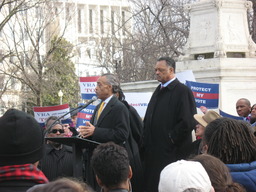
Al Sharpton and Jesse Jackson
Speak Outside Supreme Court
 Al Sharpton and Jesse Jackson Speak Outside Supreme Court |
7 JUSTICE KAGAN: -- that is the question, isn't it? 8 You said the problem has been solved. But 9 who gets to make that judgment really? Is it you, is it 10 the Court, or is it Congress? 11 MR. REIN: Well, it is certainly not me. 12 (Laughter.) 13 JUSTICE SCALIA: That's a good answer. I 14 was hoping you would say that.
I've heard some saying that Washington, D.C. is Hollywood for ugly people. I never understood the celebrity-sighting aspect of this city until I went to the Supreme Court, today.
I've been through this town and played the tourist so many times, before. There's a standard circuit of galleries I go to whenever visiting Washington, D.C.. Invariably, I'll re-visit the permanent collection of the Freer Gallery. Down and through the underground tunnel there's always some amazing temporary exhibition on display next door at the Sackler Gallery. Calling on friends and relatives who live in the area, getting my fix of whatever cuisine I've been missing or am about to miss wherever I'm next off to--the D.C. I know well always offers more than enough to keep my every day full.
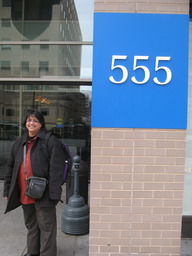 Outside Mala's Worplace |
The only thing I knew about it was that the case was scheduled at a time convenient to me. There were also oral arguments scheduled to be heard for another case this morning, something called "AMERICAN EXPRESS CO. V. ITALIAN COLORS RESTAURANT". I figured I'd be able to make it easily into one or the other. It wasn't until walking to the metro station with Mala and Vega, joining their commute into central Washington, that I realized what I was heading into.
"What's the case you're going to attend?", Mala asked me.
I cited the day's docket verbatim--as if I actually knew anything about the cases.
"Oh, I wonder if that's that big challenge to the Voting Rights Act of 1965," Vega said. "There are some counties mostly in southern states that are saying they don't need to afford voting protections anymore. If the defendant is named as Eric Holder, the Attorney General, I'll bet that's the one."
I sheepishly admitted that I had read "HOLDER" as some specific legal term I was unfamiliar with--perhaps akin to "keeper" or "guarantor".
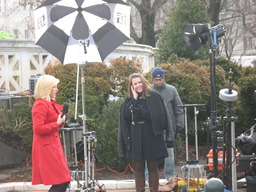 Media Coverage |
My hopes for getting inside the building to see any live-action judiciary proceedings began to dim. Why did I happen to unwittingly pick the one day a landmark case was scheduled?
We bade goodbye to Vega as she exited the train at Dupont Circle. Mala and I remained on the metro up to Union Station, the stop nearest her office. The two of us walked together to her workplace where I said goodbye and continued on to the Supreme Court.
In the plaza out front there was a small crowd bunched around a couple of men standing behind a microphone. One was speaking emotively. I tend to be lousy with faces and even worse with celebrities but instantly recognized the two as Al Sharpton and Jesse Jackson.
The media had come. No fewer than half-a-dozen video cameras mounted on tripods were aimed at the courthouse. Plenty of supporters were also on-hand, some holding up signs making statements such as "Protect my Vote!" and "¡OJO!". Detractors were present, as well. A middle-aged white man waved a homemade picket sign around above the head of a black woman wearing sunglasses walking alongside him. His sign declared: "Media Opportunity: Interview a Black Conservative".
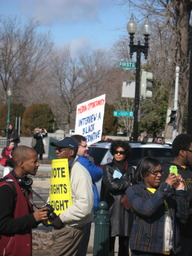 "Interview a Black Conservative" |
It was past 11:00 when the section of line I was standing in (two local law students ahead of and a pair of teachers vacationing from Florida behind me) were allowed to enter the courthouse. There were two layers of security through metal detectors. The first checkpoint additionally had an X-ray machine to inspect bags. Between the two security checks visitors were required to stow all electronic devices, including cameras, in a bank of coin-operated lockers.
Finally, we were ushered to the small corner of seats for short-term observation in the back of the Great Hall. That spot was supposed to allow only 3 to 5 minutes. Our group was fortunate. The hearing was coming to an end so no other tourist group came to claim our place. We were left to watch the proceedings for double the normal maximum time: all the way through the closing of oral arguments. I realized immediately from the dialogue that the matter at-hand had to still be Shelby County v. Holder.
I am no political junkie but once inside the Great Hall of the Supreme Court I felt fascinated to observe with my own eyes a process and a set of people I'd read about over so many years in so many headlines and articles.
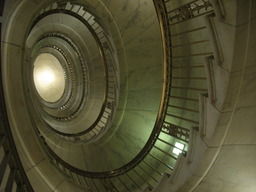 Elliptical Staircase - Supreme Court |
One of the schoolteachers who stood behind me in line had a leaflet with photos of all the justices and their seating chart. I probably wouldn't have recognized Sonia Sotomayor or Clarence Thomas walking down the street. But, with only nine faces to choose from the minorities were obvious even without the cheat sheet.
As I might have imagined, the justices were all seated in imposing, tall black chairs likely crafted from leather. What I hadn't imagined was that they were built like chairs of any other office, built to tip back and forth. Several justices rocked forward and back absent-mindedly while listening to the dialogue. At one point Clarence Thomas moved his hand up to his face. What was he doing? Was he scratching an itch?
Maybe... but for that long... eww! Did I catch a Supreme Court justice picking his nose?